MUSCULOSKELETAL RESEARCH CENTER - 2002
Savio L-Y. Woo, Ph.D., D.Sc.(Hon.) - Center Director and Vice Chairman for Research
Table of Contents
[ Introduction ]
Following her eleventh birthday, just this past December, the MSRC is gearing up for the challenges to come and putting her best foot forward. To continue her prosperity, the leadership has been expanded. The "Luck of the Irish" was bestowed upon us when Dr. Pat McMahon joined the team as the Associate Director. He's devoting 40% of his time to the research performed by "wee lads and lasses." With a positive attitude and a gift for finding the "pot of gold," he has already made a noticeable impact. Welcome to the team Pat!!
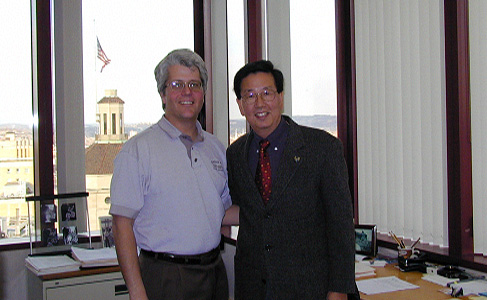
Also joining the family just this past September was the man who has the research world "up in arms." Dr. Zong-Ming Li has added to our diversity as the co-director of the Upper Extremity Laboratory. Dr. Li has traveled far and wide as he made the trek from his previous position as the Assistant Professor of Physical Therapy at Walsh University in Ohio. Dr. Li received his Bachelor's degree in Engineering Mechanics and Master's degree in Musculoskeletal Biomechanics in China. Despite his checkered past as a PhD graduate in
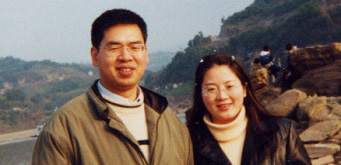 Kinesiology/Biomechanics from Penn State University (Pitt's biggest rival), we are emphatically devoted to converting him to a Panther. For the past six years, Dr. Li's unique "hands on" approach to research has guided his study of the biomechanics and motor control of the hand and fingers. His research focuses on the dreaded carpal tunnel syndrome (something we computer folk will be dealing with shortly) utilizing bioengineering approaches. Now, a first-rate team of basic and clinical scientists is in place to solve this prevalent problem by an interdisciplinary approach. Look out carpal tunnel syndrome! Dr. Li will take you on as he investigates the neuromuscular control of the hand and fingers, biomechanical assessment of hand motor function, kinematics and kinetics of the wrist, surface and fine-wire electromyography, morphometry of the wrist, and molecular mechanisms of flexor tendinitis and tenosynovitis. When he's not keeping our hands functioning safely, Dr. Li is spending time with his lovely wife, Fang Peng, an accountant at Pittsburgh Partnership for Neighborhood Development. They recently had an adorable daughter, Vivian, who was born in the year of the Horse on the day of Chinese New Year, 2002. This will be one year they will never forget!
Kinesiology/Biomechanics from Penn State University (Pitt's biggest rival), we are emphatically devoted to converting him to a Panther. For the past six years, Dr. Li's unique "hands on" approach to research has guided his study of the biomechanics and motor control of the hand and fingers. His research focuses on the dreaded carpal tunnel syndrome (something we computer folk will be dealing with shortly) utilizing bioengineering approaches. Now, a first-rate team of basic and clinical scientists is in place to solve this prevalent problem by an interdisciplinary approach. Look out carpal tunnel syndrome! Dr. Li will take you on as he investigates the neuromuscular control of the hand and fingers, biomechanical assessment of hand motor function, kinematics and kinetics of the wrist, surface and fine-wire electromyography, morphometry of the wrist, and molecular mechanisms of flexor tendinitis and tenosynovitis. When he's not keeping our hands functioning safely, Dr. Li is spending time with his lovely wife, Fang Peng, an accountant at Pittsburgh Partnership for Neighborhood Development. They recently had an adorable daughter, Vivian, who was born in the year of the Horse on the day of Chinese New Year, 2002. This will be one year they will never forget!
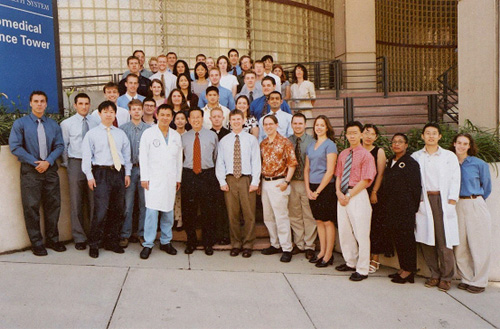
The four segments of the MSRC specialize in different areas, each with its own director are doing great this year. Drs. Savio Woo and Pat McMahon head up the bioengineering and mechanobiology section, which are located in the penthouse suites of the Biomedical Science Tower. Directed by Drs. James Kang, Raj Sinha and Constance Chu and located in Presbyterian University Hospital are the Ferguson Laboratories, the origin of orthopaedic research at Pitt. The spine group and Dr. Lars Gilbertson have also relocated to the Ferguson Laboratory, "fusing" their research space into one functional spinal unit. The Growth and Development Laboratory, located in Rangos Research Center and directed by Dr. Johnny Huard, is having a phenomenal year as they recruit muscle stem cells to cure Duchenne Muscular Dystrophy. Finally, the Neuromuscular Research Laboratory located in the Center for Sports Medicine and directed by Dr. Scott Lephart is putting its "best foot forward" as they perform gait analysis. The Ferguson, Growth and Development and Neuromuscular Research Laboratories will be discussed in more detail in subsequent sections.
There are three primary research areas of the MSRC which are 1) functional tissue engineering, 2) robotics and computational biomechanics, and 3) neuromuscular control. Our seven laboratories, Mechanobiology, Tissue Mechanics, Anterior Cruciate Ligament, Posterior Cruciate Ligament, Computer Assisted Surgery, Shoulder Dynamics, and Hand and Forearm Laboratories focus their research efforts on these three areas. Functional tissue engineering research investigates the cellular and molecular responses to mechanical stimuli and manipulates these processes to improve the outcome of healing. The robotics and computational biomechanics research uses robotic technology and computational techniques to examine joint function and detail the contribution of individual ligaments and other soft tissue structures. Specifically targeted in quantifying the in situ forces of knee and shoulder ligaments to improve ligament reconstructions with the hope of improving joint function following surgical repair. The goal of our neuromuscular control research is to advance our understanding of finger coordination mechanisms, how hand disorders affect finger coordination, and how clinical treatments can improve finger coordination. We are particularly interested in studying carpal tunnel syndrome using bioengineering principles. Our research will potentially improve prevention, diagnosis, evaluation, and treatment of carpal tunnel syndrome.
The principal investigators in the MSRC continue to collaborate in an effort to improve our understanding and provide solution to orthopaedic disease using a multidisciplinary approach. Examples include Drs. Huard and Woo working on the determination of the effect of BMP2 and BMP4 on the mechanical properties of bone. Drs. Woo and Lephart on assessing and reproducing the in vivo knee kinematics during activities of daily living. Drs. James Wang, Savio Woo, and Christopher Niyibizi on changing the collagen composition of the healing MCL using antisense gene therapy.
Collaborators from other universities and institutions continue to work with us. The Anterior Cruciate Ligament Laboratory is working with Dr. Tom Andriacchi of Stanford University to collect in vivo knee kinematics using the point cluster technique. Dr. Steve Badylak at Purdue University is collaborating with the Functional Tissue Engineering Research Team to evaluate the healing MCL repaired with SIS scaffolds. We are working with Dr. Cyril Frank at the University of Calgary to develop antisense oligonucleotides and Dr. Leaf Huang at the University of Pittsburgh to deliver antisense gene therapy both with the goal of enhancing MCL healing. The Shoulder Dynamics Laboratory is working with Dr. Thay Lee, at the University of California, Irvine, to study the pattern and shape of rotator cuff tears in the shoulder. The Shoulder Dynamics Laboratory and Functional Tissue Engineering Research Team are also collaborating with Dr. Jeff Weiss of the University of Utah on computational modeling of glenohumeral capsule at the shoulder and the knee. The Shoulder Dynamics Laboratory is collaborating with Dr. Michael Sacks of the University of Pittsburgh to evaluate collagen fiber orientation in the inferior glenohumeral ligament. Dr. Wang received a grant from Hewlitt International for the purpose of establishing academic collaborations overseas. Dr. Wang traveled to China for two weeks in March for this purpose.
This past year was both exciting and successful for the MSRC, as we submitted and received several grants, hosted a symposium, welcomed new personnel, presented posters and podiums at national and international meetings and applauded the recipients of several national awards.
We have done well by submitting a large number of proposals to the National Institutes of Health (NIH). The Functional Tissue Engineering Research Group, under the direction of Drs. Woo and Wang, was successful in a competitive renewal of the NIH Grant "MCL Healing: Interdisciplinary Studies" for over $2 million. This is the third time that NIH has renewed this project. The goal of this project is to develop strategies that improve ligament healing, specifically the MCL. The Anterior Cruciate Ligament Laboratory, under the direction of Drs. Woo and Debski, was also successful in a competitive renewal for $1.5 million to study in situ forces in the ACL. This is the fourth time that NIH has renewed this project. The goal of this project is to determine the in situ force distribution in the ACL and ACL replacement grafts during activities of daily living. Drs. Michael Chancellor and Johnny Huard were also successful extending a grant from NIH to study muscle cell mediated gene therapy for incontinence. The Shoulder Dynamics Laboratory, under the direction of Drs. McMahon and Richard Debski, submitted a proposal for nearly $1 million to study glenohumeral joint stability. The overall objective is to improve the treatment of shoulder joint dislocation, which is the most commonly dislocated joint. Also the tendinitis group, under the direction of Dr. Wang, submitted a new NIH grant for $800,000 to study tendon inflammation and degradation.
Currently, our department has 12 funded NIH Grants worth over $10 million and has submitted an additional 5 proposals worth over $5.5 million. The following table summarizes our NIH funded research:
| Currently Funded NIH Grants | ||||
| 1. NIH R01 | Drs. Woo / Fu / Debski | In-situ forces in ACLs | 4 years | 1,416,626.00 |
| 2. NIH R01 | Drs. Woo / Wang / Niyibizi | MCL Healing | 5 years | 2,059,896.00 |
| 3. NIH R21 | Dr. Niyibizi | Gene Therapy for OI | 2 years | 145,302.00 |
| 4. NIH R21 | Dr. Chu | Superoxide Dismutase | 3 years | 321,986.00 |
| 5. NIH R01 | Dr. Huard | Muscle Healing | 4 years | 1,071,720.00 |
| 6. NIH R01 | Dr. Huard | Bone Healing | 5 years | 1,624,012.00 |
| 7. NIH R01 | Drs. Gilbertson / Kang | Robotic Spine Testing | 3 years | 721,348.00 |
| 8. NIH R01 | Drs. Cauley / Vogt | Lumbar Spinal Stenosis | 4 years | 311,216.00 |
| 9. NIH R01 | Drs. Chancellor / Huard | Gene Therapy for Incontinence | 5 years | 381,000.00 |
| 10. NIH P01 | Drs. Huang / Huard | Myofibers | 5 years | 1,063,304.00 |
| 11. NIH P30 | Drs. Wright / Wang | Tendinitis | 3 years | 225,000.00 |
| 12. NIH R01 | Drs. Marion / Lovell | MRI & Sp Related Concussion | 5 years | 681,690.00 |
| Total Funded NIH Grants | $ 10,023,100.00 | |||
| Pending NIH Grants | ||||
| 1. NIH R01 | Dr. Huard | Stem Cell Transplantation | 5 years | 1,175,402.00 |
| 2. NIH R01 | Drs. McMahon / Debski | Restoring Joint Stability | 5 years | 1,143,613.00 |
| 3. NIH R01 | Dr. Kang | Matrix Synthesis | 5 years | 1,745,937.00 |
| 4. NIH R01 | Dr. Wang | Mechanisms for Tendinitis | 4 years | 1,051,071.00 |
| 5. NIH Core | Drs. Wagner / Huard | Precursor Cell Isolation | 5 years | 528,284.00 |
| Total Pending NIH Grants | $ 5,644,307.00 | |||
We have also been successful in gaining extramural funding from other sources. The Whitaker Foundation has awarded a three-year grant for $165,600 to Drs. Wang and Woo in the Department of Bioengineering for the establishment of an Industrial Internship program. The Industrial Internship Program is designed to assist bioengineering students in achieving educational and career goals. This program will provide a mechanism for an individualized, industrial-based educational internship experience. Dr. Wang received a grant from CMRF for $25,000 to study how altering mechanical stretching affects human aortic tissue and a $240,000 grant from the Whitaker Foundation to conduct a bioengineering study of the mechanism of tendinitis. Drs. Peter Tang and Jamie Pfaeffle were awarded Resident Research Grants from the Orthopaedic Research and Education Foundation (OREF). Nationwide, only twelve Resident Grants were funded this year - so we are extremely proud to have two at our institution. Dr. Tang was awarded $15,000 for his project entitled "Is anatomic reconstruction biomechanically superior to conventional ACL reconstruction? - An in vivo goat study." Dr. Pfaeffle's Resident Research Award was funded by Organon Sanfoli-Sythelabo, L.L.C. for $10,900 for the proposal entitled "Analysis of functional bundles and isometry in the interosseous ligament of the forearm."
Drs. Li and Wang submitted a grant to Rockefeller Brothers for $25,000 to study carpal tunnel syndrome. Dr. Li also submitted a grant for $239,869 to the Whitaker Foundation to study human finger coordination and a grant for $100,000 to the Aircast Foundation to study hand motor function.
Our high productivity is evidenced by not only grants, but also by the papers we publish, abstracts we present at meetings, and the exciting findings gained through our research. Among the papers that we published last year was "The Biomechanical Interdependence Between the ACL Replacement Graft and the Medial Meniscus" by Dr. Christos Papageorgiou, Mr. Jorge Gil, Dr. Akihiro Kanamori, Dr. James Fenwick, Dr. Woo, and Dr. Fu published in the American Journal of Sports Medicine, winner of the 2000 Albert Trillat Award, established a biomechanical relationship between the ACL and the medial meniscus. "Effect of Capsular Injury on Acromioclavicular Joint Mechanics" by Drs. Debski, Parsons, Woo and Fu published in the Journal of Bone and Joint Surgery quantified the effect of transection of the acromioclavicular joint capsule on the kinematics and the in situ forces in the coracoclavicular ligaments in response to external loading conditions. "A Multi-Disciplinary Study of the Healing of an Intra-Articular Anterior Cruciate Ligament Graft in a Goat Model" by Dr. Papageorgiou, Dr. Ma, Mr. Abramowitch, Mr. Clineff, and Dr. Woo published in the American Journal of Sports Medicine analyzed the function of the reconstructed knee and the biomechanical and histologic properties of an intra-articular ACL replacement graft during the early stages of healing. Furthermore, we had a 100% acceptance rate of our abstracts at the Orthopaedic Research Society (ORS) Annual Meeting. This has been a goal of ours for several years and this is the first year that we have achieved it.
Many visiting professors continue to grace our research center during the year. In return for showing off the sites and sounds of the best city in the world (Pittsburgh, of course, what were you thinking!!!), we have heard lectures from speakers from academia, industry and federal agencies. In June, Dr. Alan Russell, the director of the newly formed McGowan Institute for Regenerative Medicine and also Executive Director of the Pittsburgh Tissue Engineering Initiative visited the MSRC and delivered an exciting lecture on "Interdisciplinary challenges of regenerative medicine." In September, Dr. Shinro Takai from Kyoto Prefectural University spoke to us about "Biomechanical properties of growth plate and callus." In November, Dr. Al Giovanella, the Executive Health Science Associate at Merck & Co., Inc., spoke on "G-protein coupled receptors: their role in mechanotransduction." In December, we were visited by Dr. Mark Eastwood, who is the Director of the Center for Tissue Engineering Research at the University of Westminster in London England, who delivered a talk entitled "From mechanical force to bioreactor: tissue engineering heart valves and blood vessels." In March, we were visited by Dr. Hiromichi Fujie, who is Associate Professor and Director of Biomechanics Laboratory at Kogakuin University, spoke to us about the "Application of a robotic system to study joint biomechanics." Dr. Steven Badylak, a senior research scientist in the Department of Biomedical Engineering at Purdue University and our collaborator, spoke to us about "Extracellular Matrix Scaffolds for Musculoskeletal Repair." Also, in March Dr. Aaron Schopper, Dr. Reng Dong, and Dr. John Wu, from the National Institute for Occupational Safety and Health (NIOSH) lectured on "The study of the musculoskeletal system at ECTB, NIOSH."
MSRC continues to be a popular research center that attracts from around the world, including Germany, Spain, Chile, Brazil, China, Austria, Columbia, Belgium, Saudi Arabia, Canada, Japan and South Korea. Approximately one hundred visitors including traveling fellows, residents, professors from other universities, and guests from industry have toured our facilities this year. Amongst our distinguished visitors include Dr. Y. C. Fung ("the father of biomechanics") from the University of California at San Diago, Dean Arthur Levine from University of Pittsburgh School of Medicine, Dr. Lars Englebretesen from the University of Oslo, Dr. Jennifer Wayne from Virginia Commonwealth University, Dr. Yu Changlong from the Institute of Sports Medicine at the Universtiy of Peking, Dr. Jo Hannafin from the Hospital for Special Surgery and Dr. Iannotti of the Cleveland Clinic Foundation, Dr. Van Mow from Columbia University, Dr. Cy Frank from the University of Calgary, Dr. Michael Lai from Columbia University, Dr. Thay Lee from University of California, Irvine, Dr. Nilay Mukherjee from West Virginia University, Dr. Masataka Sakane from Ibaraki Prefectural University in Japan, and Dr. Woo's brothers Dr. Savio L. C. Woo from the Albert Einstein College of Medicine and Mr. L.C. Woo from Vancouver.
[ top ]
[ Achievments ]
We continued to have high achievements and receive recognition from our peers. Fellows, students and faculty certainly made the MSRC proud as they brought home major awards from national and international societies.
Dr. Woo received the Carnegie Visiting Professorship sponsored by the University Court of the Universities of Scotland. The Carnegie Visiting Professorship is one of the highest honors from the highest academic institutes in Scotland. Dr. and Mrs. Woo are invited to go to Scotland in June and August to work with Professor Malcolm Pope at the University of Aberdeen as well as six other universities in Scotland. In addition, there will be an opportunity for Dr. Woo to present his work to a wider audience. The Carnegie Visiting Professorship provides resources in the amount of £40,000 (about $60,000 U.S.) to allow Dr. Woo to bring along some of his graduate students and research fellows to visit the universities as well as develop collaborative projects with Dr. Pope and others. It is a great opportunity for our department as well as the MSRC to explore the use of vertical MRI to study the in vivo kinematics of the knee and shoulder joints.
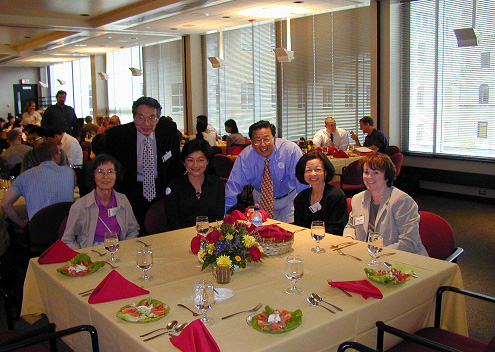
The Posterior Cruciate Ligament Laboratory received two prestigious awards this year. The 2001 Hughston Award for the best original paper in the American Journal of Sports Medicine in 2000, entitled "Biomechanical analysis of a double-bundle posterior cruciate ligament reconstruction" by Dr. Christopher Harner, Ms. Marsie Janushek, Dr. Akihiro Kanamori, Dr. Masayoshi Yagi, Ms. Tracy Vogrin, and Dr. Woo and the Aircast Basic Science Research Award from the American Orthopaedic Society for Sports Medicine for the work entitled "Importance of tibial slope for stability of the PCL-deficient knee" by Dr. Robert Giffin, Ms. Vogrin, Ms. Kitty Stabile, Mr. Thore Zantop, Dr. Woo, and Dr. Harner. We congratulate all members of the team for the continuing success particularly in their pioneering work involving this important area of research. The Anterior Cruciate Ligament Laboratory also received a prestigious award from the Arthroscopy Association of North America. The 2002 Richard O'Connor Award was earned by Drs. John Loh, Yukihisa Fukuda, Eiichi Tusuda, Richard Steadman, Fu and Woo for their work entitled "Does lateralization of femoral tunnel placement improve anterior cruciate ligament graft function?"
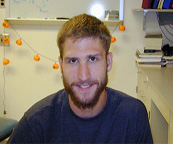
 Mr. Brian Campbell was awarded a $15,000 scholarship from the Wellington C. Carl Fund of the Pittsburgh Foundation for work on his master's thesis project entitled "Enhancing the quality of wound healing by control of cellular contraction." Mr. Campbell is planning to attend medical school once he completes a master's degree in Bioengineering. Dr. Wang earned the Hulda Irene Duggan Arthritis Foundation Investigator of the Year Award, a distinction given annually to the highest ranked Arthritis Investigators. Congratulations to both of them.
Mr. Brian Campbell was awarded a $15,000 scholarship from the Wellington C. Carl Fund of the Pittsburgh Foundation for work on his master's thesis project entitled "Enhancing the quality of wound healing by control of cellular contraction." Mr. Campbell is planning to attend medical school once he completes a master's degree in Bioengineering. Dr. Wang earned the Hulda Irene Duggan Arthritis Foundation Investigator of the Year Award, a distinction given annually to the highest ranked Arthritis Investigators. Congratulations to both of them.
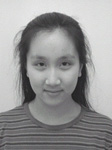 Rena Xu, who is an undergraduate student that worked with us during the summer, participated in the Pennsylvania Junior Academy of Science competition in February and won First Place and also received the Director's Award for excellence in biochemistry. This honor also included a $100 prize. We believe Rena's future is unlimited. Congrats!
Rena Xu, who is an undergraduate student that worked with us during the summer, participated in the Pennsylvania Junior Academy of Science competition in February and won First Place and also received the Director's Award for excellence in biochemistry. This honor also included a $100 prize. We believe Rena's future is unlimited. Congrats!
During this past year, Ms. Mary Gabriel defended her master's thesis entitled "Determination of the strain distribution in the interosseous ligament using an instrumented spatial linkage." Ms. Gabriel is currently working with us as a staff research engineer. Ms. Jennifer Zeminski also defended her master's thesis entitled "Development of a combined analytical and experimental approach to reproduce knee kinematics for the evaluation of anterior cruciate ligament function." Ms. Zeminski is currently living in Japan. Mrs. Kitty Stabile also defended her master's thesis entitled "Investigation of the human forearm interosseous ligament: experimental and computational analysis." Mrs. Stabile is planning on attending medical school next year. Congratulations and best wishes to all of them.
[ top ]
[ Personnel ]
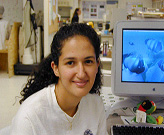
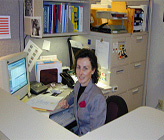 During the past year we have welcomed several new faces, and some interesting personalities, to the MSRC. Dr. Tomoyuki Sasaki from Hirosaki University of Japan joined us and is performing ACL research. Dr. Sasaki is investigating the effect of femoral tunnel angle on the function of an ACL reconstruction. Ms. Mary Gabriel has decided that the MSRC is too good to be true and is now working with us as a staff research engineer with the ACL group. Ms. Gabriel is working on collecting and replaying knee motion on the robotic testing system. Mrs. Jane Peart has joined the MSRC as Dr. Woo's executive secretary. As a certified Penn State Master Gardener, Mrs. Peart volunteers her time educating others about gardening (I guess it's safe to say she's rolling in the green stuff). We also have a new member in our finance department, Anthony Montanaro, B.S. who has joined us from LaRoche College where he majored in accounting and management. Don't worry folks; we did a thorough background check for the man who handles that much dough. We are very happy that they are all in the MSRC family.
During the past year we have welcomed several new faces, and some interesting personalities, to the MSRC. Dr. Tomoyuki Sasaki from Hirosaki University of Japan joined us and is performing ACL research. Dr. Sasaki is investigating the effect of femoral tunnel angle on the function of an ACL reconstruction. Ms. Mary Gabriel has decided that the MSRC is too good to be true and is now working with us as a staff research engineer with the ACL group. Ms. Gabriel is working on collecting and replaying knee motion on the robotic testing system. Mrs. Jane Peart has joined the MSRC as Dr. Woo's executive secretary. As a certified Penn State Master Gardener, Mrs. Peart volunteers her time educating others about gardening (I guess it's safe to say she's rolling in the green stuff). We also have a new member in our finance department, Anthony Montanaro, B.S. who has joined us from LaRoche College where he majored in accounting and management. Don't worry folks; we did a thorough background check for the man who handles that much dough. We are very happy that they are all in the MSRC family.
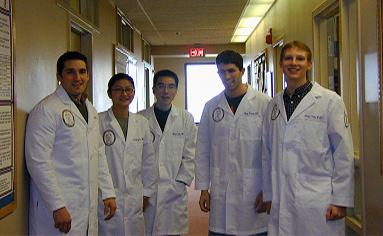 The MSRC welcomed several new and devoted graduate students this year. Ryan Costic, B.S. is working with Dr. Debski in the Shoulder Dynamics Laboratory, he's one of the University of Pittsburgh's best, playing varsity soccer while earning a bachelor's degree in bioengineering. Two graduate students joined the ACL group: Jesse Fisk, B.S. who earned a degree in Mechanical Engineering from Bucknell University, the first Maine native in the MSRC, and Guy Emry, B.S., a decathlete, who also earned a degree in Mechanical Engineering from the University of Miami. It wouldn't be the MSRC if we didn't embrace cultural diversity. Two new graduate students joined the MCL group: Jinhong Zhu, M.D. from Shanghai Second Medical University where she was a Ph.D candidate and Weiqun Yu, M.S. from Chongqing University where he received a degree in Biomedical Engineering. Mr. Yu will be getting married in the upcoming year.
The MSRC welcomed several new and devoted graduate students this year. Ryan Costic, B.S. is working with Dr. Debski in the Shoulder Dynamics Laboratory, he's one of the University of Pittsburgh's best, playing varsity soccer while earning a bachelor's degree in bioengineering. Two graduate students joined the ACL group: Jesse Fisk, B.S. who earned a degree in Mechanical Engineering from Bucknell University, the first Maine native in the MSRC, and Guy Emry, B.S., a decathlete, who also earned a degree in Mechanical Engineering from the University of Miami. It wouldn't be the MSRC if we didn't embrace cultural diversity. Two new graduate students joined the MCL group: Jinhong Zhu, M.D. from Shanghai Second Medical University where she was a Ph.D candidate and Weiqun Yu, M.S. from Chongqing University where he received a degree in Biomedical Engineering. Mr. Yu will be getting married in the upcoming year.
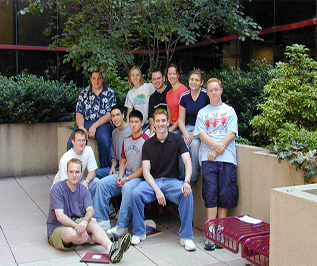 This past summer, we continued to be energized by a number of enthusiastic undergraduate students who spent thirteen weeks with us at the MSRC. In the Summer Undergraduate Research Program, these students have the opportunity to work directly with a team from one of the research groups throughout the summer. The program culminates with a symposium at the end of the summer, where each student presents his or her accomplishments. This years students included Greg Frank, Nima Salari, Brian Civic, Jennifer Mercer, John Jolly, and Kevin Bell from the University of Pittsburgh, Bradley Stokan, James Chung, Katie Yoder from Carnegie Mellon University, Allison Westcott from the University of Toledo and Charles Vukotich from Northwestern University. Their projects were very diverse this year. Mr. Bell developed a new control method for the robotic/universal force-moment testing system while Mr. Chung investigated the changes in knee kinematics when portions of the medial meniscus are removed. Mr. Civic and Mr. Salari were busy studying the effect of PGE2 on tendon fibroblast proliferation and collagen synthesis, meanwhile Mr. Frank was examining the tensile properties of healing goat MCL and Mr. Jolly was determining the dislocation potential of shoulder muscles. Also working hard were Ms. Mercer determining the collagen fiber alignment of the axillary pouch of the glenohumeral capsule in the shoulder, Mr. Stokan validating a method of transforming and reproducing kinematics, and Mr. Vukotich creating 3-D models of the human ACL. This summer, Ms. Westcott determined an antisense effective target site and Ms. Yoder calculated the accuracy and repeatability of reproducing the rotational center of the tibia in relation to the ACL. We put them to the test, but they came through with flying colors and dazzled us all.
This past summer, we continued to be energized by a number of enthusiastic undergraduate students who spent thirteen weeks with us at the MSRC. In the Summer Undergraduate Research Program, these students have the opportunity to work directly with a team from one of the research groups throughout the summer. The program culminates with a symposium at the end of the summer, where each student presents his or her accomplishments. This years students included Greg Frank, Nima Salari, Brian Civic, Jennifer Mercer, John Jolly, and Kevin Bell from the University of Pittsburgh, Bradley Stokan, James Chung, Katie Yoder from Carnegie Mellon University, Allison Westcott from the University of Toledo and Charles Vukotich from Northwestern University. Their projects were very diverse this year. Mr. Bell developed a new control method for the robotic/universal force-moment testing system while Mr. Chung investigated the changes in knee kinematics when portions of the medial meniscus are removed. Mr. Civic and Mr. Salari were busy studying the effect of PGE2 on tendon fibroblast proliferation and collagen synthesis, meanwhile Mr. Frank was examining the tensile properties of healing goat MCL and Mr. Jolly was determining the dislocation potential of shoulder muscles. Also working hard were Ms. Mercer determining the collagen fiber alignment of the axillary pouch of the glenohumeral capsule in the shoulder, Mr. Stokan validating a method of transforming and reproducing kinematics, and Mr. Vukotich creating 3-D models of the human ACL. This summer, Ms. Westcott determined an antisense effective target site and Ms. Yoder calculated the accuracy and repeatability of reproducing the rotational center of the tibia in relation to the ACL. We put them to the test, but they came through with flying colors and dazzled us all.
We also welcomed four first-year residents in July 2001 to spend a year doing orthopaedic related research in the MSRC. Dave Hannallah, M.D. is working in the Growth and Development Laboratory and Corey Wallach, M.D. is in the Ferguson laboratory and their projects will be discussed in subsequent sections. Jamie Pfaeffle, M.D., Ph.D and Peter Tang, M.D., MPH are performing biomechanics and mechanobiology related musculoskeletal research. Dr. Pfaeffle completed an MD/PhD program and the University of Pittsburgh and is working on projects in the Upper Extremity Group under the direction of Drs. Li and Tomaino. Dr. Pfaeffle's current research project is focused on the design and evaluation of an interosseous ligament reconstruction. He has received a grant from OREF to perform this work. Dr. Tang received his degree from Cornell University and is working on projects in the ACL and MCL groups under the direction of Drs. Woo, Debski, and Wang. Dr. Tang's current research project is focused on improving ligament healing with type V antisense gene therapy.
[ top ]
[ Special and Social Events ]
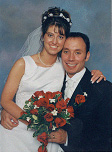
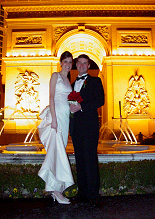 There were two weddings this year. On June 2nd, Steven Abramowitch married Deborah Brandt in Harrisburg, PA. Also, on December 30th, Jamie Pfaeffle married Tara Beckman in Las Vegas, NV. Congratulations and best wishes to the newlyweds.
There were two weddings this year. On June 2nd, Steven Abramowitch married Deborah Brandt in Harrisburg, PA. Also, on December 30th, Jamie Pfaeffle married Tara Beckman in Las Vegas, NV. Congratulations and best wishes to the newlyweds.
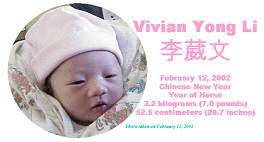
The members of the MSRC continue to bring new additions to us. Dr. Li and his wife, Fang Peng, celebrated the birth of their first daughter, Vivian, on February 12, the Chinese New Year. It is the year of the horse.
The MSRC held its annual summer picnic at my house. This year Damon's catered the meal. We had barbequed ribs and chicken and enjoyed a variety of potluck appetizers and deserts. (Wow! No Chinese food - What happened?) We were especially fortunate this year as many distinguished guests were able to join our picnic such as Dr. and Mrs. Y. C. Fung from the University of California, San Diego, Dr. and Mrs. Van Mow from Columbia University, Ms. Lynette Fleck, Dr. Cy Frank from the University of Calgary, Dr. Michael Lai from Columbia University, Dr. Thay Lee from University of California, Irvine, Dr. Nilay Mukherjee from West Virginia University, Ms. Karen Ohland from the Metropolitan Museum of Art in New York City, Dr. Masataka Sakane from Ibaraki Prefectural University in Japan, Dr. Jennifer Wayne from Virginia Commonwealth University, and my brother Dr. Savio L-C. Woo from the Albert Einstein College of Medicine graced our party.
December brought the holidays and the 5th annual MSRC Christmas Brunch. The brunch was held in Scaife Hall. It was a wonderful morning shared by the MSRC. Mrs. Pattie Woo, Mrs. Mandy Debski, and Miss Riley Debski also joined us to make it a truly special event. Also, the official announcement that Dr. Patrick McMahon has been appointed the Associate Director of the MSRC was made.
During ORS in February, the MSRC, once again, made a great showing presenting posters and presentations with clarity and panache. The MSRC luncheon was held at Uncle Tai's in Dallas Texas. We enjoyed a delicious lunch on the Chinese New Year and learned the personality traits associated with the year in which we were all born. The students presented the faculty and Chinese fellows with cards and traditional gifts given on Chinese New Year. It was extraordinarily entertaining and a cultural education for us.
[ top ]
